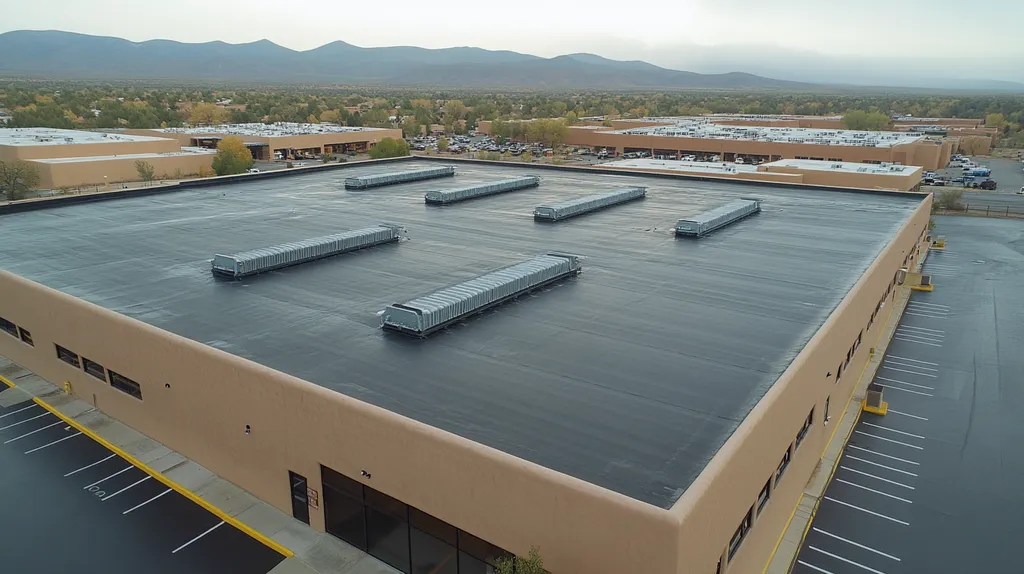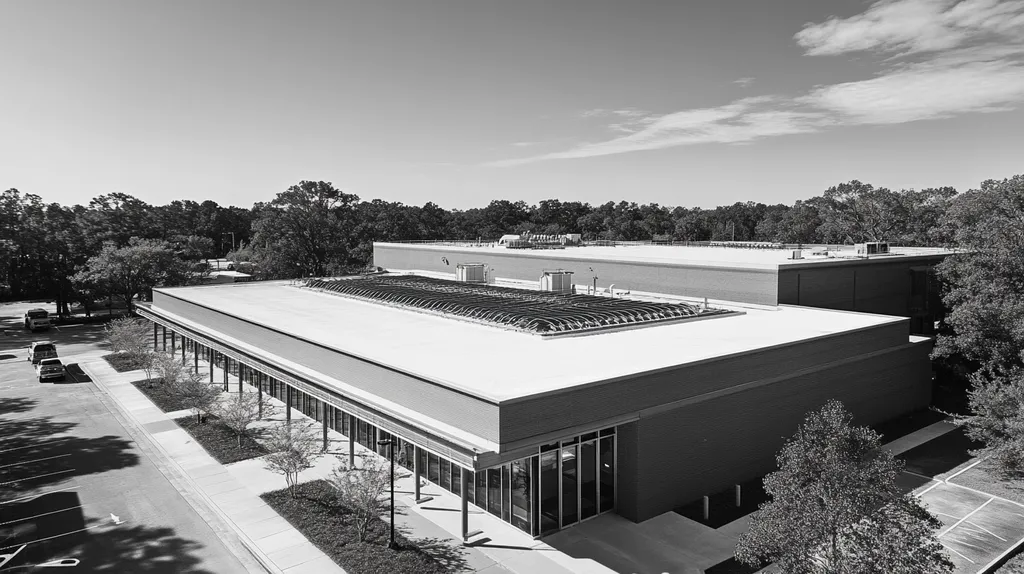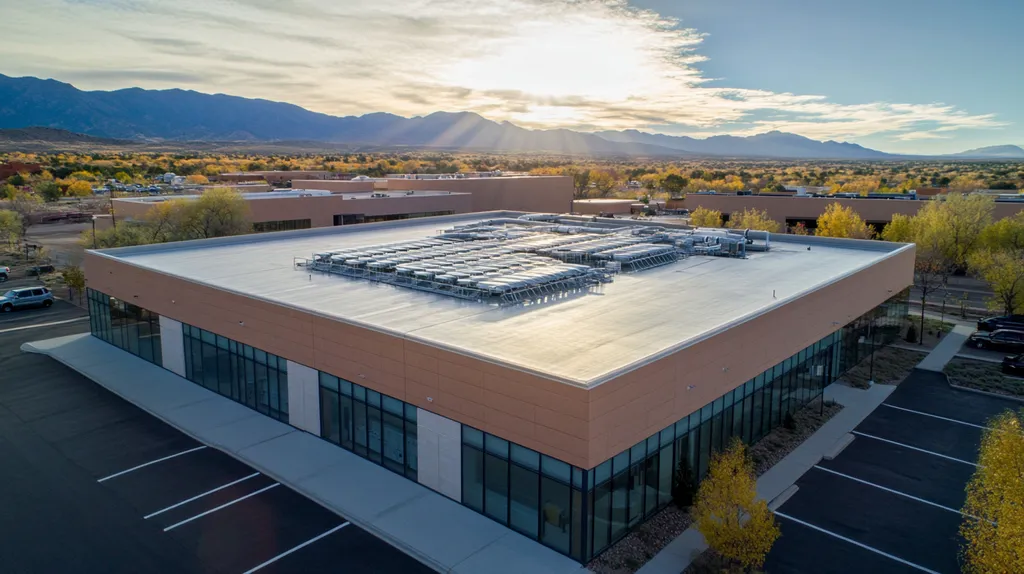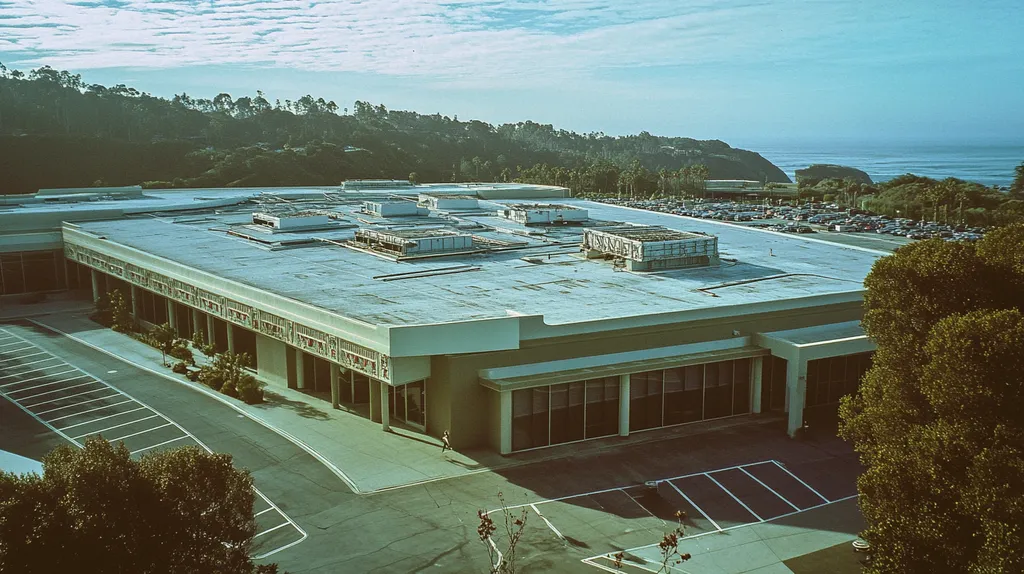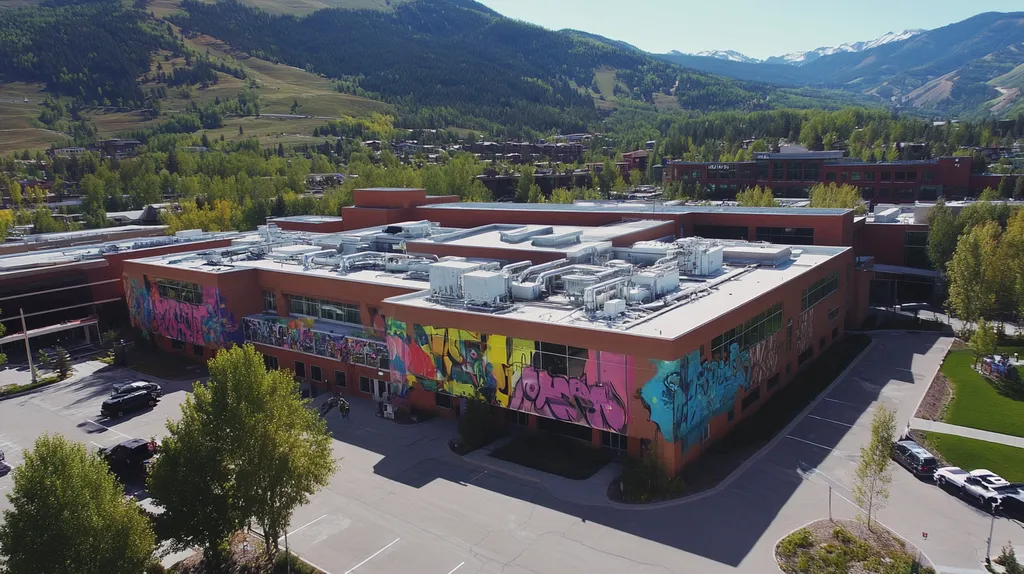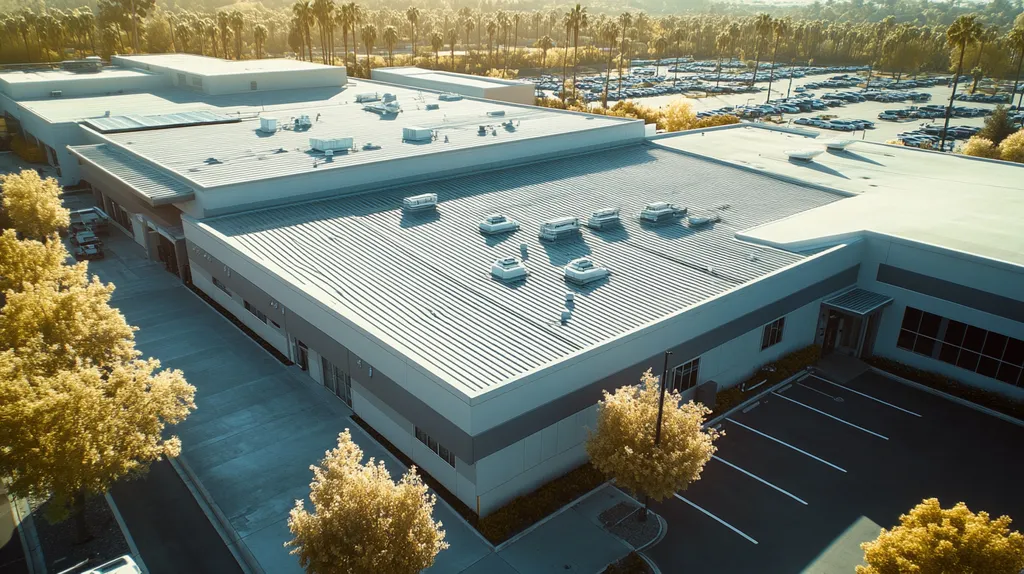In commercial roofing, outdated lighting systems waste over $17 billion annually in energy costs across U.S. businesses, yet many facility managers remain trapped by persistent industry myths about lighting alternatives.
From misconceptions about LED costs to confusion over fixture requirements, these false beliefs prevent properties from achieving up to 75% reduction in lighting expenses.
This article examines the real costs of lighting misinformation, unpacks common industry myths, and provides evidence-based alternatives that optimize both energy efficiency and workplace safety.
SECTION 1: COMMON MISCONCEPTIONS
In the rapidly changing world of commercial roofing, misunderstandings about lighting solutions can prevent property owners and facility managers from making informed decisions. Many still cling to outdated views on fluorescent lights, believe that high ceilings demand specialized fixtures, or assume LED lights are too costly. These misconceptions can lead to missed opportunities for enhanced efficiency and significant cost savings. It’s essential to clarify these points to unlock potential benefits and optimize energy usage in commercial spaces.
Fluorescent Lights are Still Efficient
Some property owners mistakenly believe that fluorescent lights are an efficient choice, but this perception is no longer valid. These bulbs consume more energy than modern alternatives and typically have a shorter lifespan, resulting in frequent replacements. Over time, the combined costs of energy consumption and maintenance can greatly exceed any upfront savings.
On the other hand, advanced lighting options like LEDs shine in comparison. They offer higher lumens per watt, which means brighter lighting at a lower energy cost. In fact, switching to LED can cut lighting energy use by up to 75%.
Moreover, LEDs have a long lifespan, often exceeding 25,000 hours, while fluorescent lights usually last around 10,000 hours. This durability reduces waste and minimizes the labor costs associated with frequent replacements.
Given these advantages, sticking with fluorescent lights can hinder operational efficiency and escalate expenses. Property managers should reconsider their lighting choices to align with modern solutions.
High Ceilings Require Specialized Fixtures Only
A prevalent misconception is that buildings with high ceilings must use specialized lighting fixtures. This belief limits options and often leads to increased costs for property owners. While certain fixtures might be advantageous, there are effective lighting solutions available that can easily illuminate high spaces without breaking the bank.
For instance, high-output LED lights can deliver ample illumination for high-ceiling areas without the need for specialized fixtures. These lights can be mounted using existing setups and require less maintenance, which enhances the overall return on investment.
Additionally, advancements in lighting technology have introduced smart controls that allow for adaptable lighting solutions in spaces with varying ceiling heights. This flexibility not only conserves energy but also ensures adequate brightness throughout the area.
Consequently, the belief that only specialized fixtures are suitable for high ceilings limits the array of lighting options for commercial property managers.
LED Lights are Too Expensive
Many facility managers tend to avoid LED lights due to perceptions of high initial costs. However, this view fails to account for the long-term savings that come with LEDs. While the upfront investment may be higher, the energy efficiency and lower maintenance needs lead to significant cost savings over time.
For example, an LED may cost 20-30% more initially than a fluorescent light, but the energy savings can be up to 75% less each month. Over the lifespan of the product, the savings can add up, often resulting in a return on investment in two years or less.
Moreover, transitioning to LED lighting frequently qualifies facilities for energy rebates, helping to offset initial expenditures. These incentives promote the adoption of energy-efficient technologies and demonstrate that this investment supports operational sustainability rather than just being an added expense.
Thus, dismissing LEDs as too expensive overlooks their true value. Property owners are encouraged to reevaluate their lighting strategies in favor of more sustainable and economically sound solutions.
SECTION 2: PRACTICAL IMPLICATIONS
When commercial property owners and facility managers explore alternatives to traditional lighting, the impact is substantial. Poor lighting choices can significantly escalate energy consumption and operational costs, leading to tighter profit margins. The U.S. Department of Energy reveals that lighting accounts for nearly 15% of energy use in commercial buildings. Recognizing the implications of various lighting options is essential for making informed and strategic decisions.
Energy Consumption and Operational Costs
Transitioning from traditional lighting to energy-efficient alternatives like LED or solar-powered fixtures can dramatically reduce energy use. For instance, LED lights can consume up to 75% less energy than conventional incandescent bulbs, resulting in noticeable reductions in utility bills and overall operational costs.
Additionally, solar-powered lighting options eliminate energy expenses altogether. By harnessing renewable energy, property owners can significantly lessen their dependency on the grid, making solar fixtures an appealing choice.
While upfront costs for alternative lighting may be higher, the long-term savings often outweigh these initial investments. The impressive durability of these alternatives contributes to further energy savings.
Adopting energy-efficient lighting also aligns with sustainability initiatives, allowing property owners to promote lower carbon footprints. This not only benefits the environment but can enhance a brand’s reputation in a marketplace increasingly focused on eco-conscious practices.
Maintenance Requirements and Lifespan
Maintenance is a critical consideration when comparing lighting choices. Traditional lights frequently require bulb replacements, resulting in both hidden costs and operational interruptions. In contrast, alternatives like LED and solar lights boast impressive lifespans of 25,000 to 50,000 hours, significantly reducing the need for maintenance.
Less frequent maintenance not only saves money but also minimizes disruptions in daily operations. For facility managers, this translates to less downtime and a more efficient workflow, which increases overall productivity.
Furthermore, opting for longer-lasting solutions mitigates environmental impacts. Reducing waste from discarded bulbs aligns with sustainability goals, thereby reducing an organization’s footprint on landfills.
Ultimately, these practical implications underscore the importance of upgrading lighting systems to more durable alternatives. Investing in modern lighting means ensuring a longer-lasting solution while improving operational efficiency.
Lighting Distribution and Uniformity
The distribution and uniformity of light are essential factors for both safety and productivity in commercial spaces. Traditional lighting often results in uneven illumination, leading to shadows that can create hazards or hinder worker efficiency. In contrast, alternatives like LED systems provide superior distribution, ensuring consistent lighting across all areas.
In larger facilities, the advantages of improved light quality are even more pronounced. Enhanced uniformity reduces the risk of accidents, allowing employees to work effectively in well-lit environments. When workers can see clearly and move safely, productivity tends to rise.
Additionally, smart lighting systems that adapt based on natural light levels further optimize light distribution. These advancements not only improve uniformity but also contribute to energy savings through real-time adjustments based on current needs.
Choosing alternative lighting options offers tangible benefits in terms of safety and operational efficiency. Investing in superior lighting translates to a safer, more productive workspace.
SECTION 3: COST OF MISINFORMATION
Making the right lighting choices for commercial roofs is more critical than ever. Inefficient lighting not only drives up energy costs but can also adversely affect productivity. As hidden costs accumulate, the financial implications of sticking with outdated technologies can be staggering. Addressing these issues is paramount, as the potential for misinformation looms large in this vital area.
Financial Impact of Inefficient Lighting
Inefficient lighting systems can severely impact a commercial property’s finances. Traditional solutions often consume excessive energy, leading to inflated monthly utility bills. For instance, a typical 400-watt metal halide fixture used in warehouses may incur operating costs exceeding $400 annually, while an equivalent LED system costs only about $100 per year.
Moreover, outdated lighting can contribute to higher maintenance expenses. The shorter lifespan of old bulbs means more frequent replacements and additional labor costs, negatively affecting a company’s bottom line. Furthermore, for businesses that depend on adequate lighting for both safety and productivity, insufficient illumination can lead to disrupted workflows and inefficiencies.
When considering all these factors, poor lighting choices can cost property owners thousands each year. Understanding the true financial consequences encourages facility managers to make wiser decisions, helping to avoid unnecessary expenses.
Investing in efficient lighting alternatives not only curtails bills but also frees up funds for other essential facility needs.
Opportunity Costs of Outdated Technology
Relying on outdated lighting technology results in significant opportunity costs for commercial property owners. Modern lighting alternatives provide improved energy efficiency, leading to substantial long-term savings and enhanced productivity. By embracing advanced lighting solutions, organizations can cultivate a better work environment.
Additionally, older lighting systems often hinder the ability to leverage new building technologies. For example, modern smart lighting systems offer automated controls that adjust energy consumption based on actual usage, yielding cost savings that traditional systems cannot achieve.
Organizations stuck with obsolete lighting also risk missing out on governmental rebates or incentives aimed at promoting energy efficiency. These financial opportunities reflect immediate savings as well as a commitment to Sustainable practices.
This untapped potential can stifle financial progress, as businesses fail to take full advantage of the benefits that innovative lighting technologies can bring.
Environmental Consequences of Energy Waste
The environmental effects of clinging to inefficient lighting are significant and widespread. Energy waste not only contributes to higher carbon emissions but also exacerbates climate change, affecting communities and economies alike. Transitioning to LED lighting, for instance, can reduce energy use by up to 80%, thereby dramatically lowering a building’s carbon footprint.
Furthermore, the production and disposal of outdated lighting technologies entail environmental costs that extend beyond the individual organization. Traditional bulbs often contain hazardous materials, requiring careful disposal to avoid environmental harm. Embracing modern alternatives helps organizations reduce these risks and showcase their commitment to corporate responsibility.
In a world where sustainability is increasingly prioritized, businesses that disregard lighting advancements risk damaging their reputations. Stakeholders expect companies to embrace eco-friendly practices. Thus, wasted energy not only harms the environment but also reflects a company’s dedication to sustainability.
Recognizing these environmental consequences underscores the importance of combating misinformation and advocating for updated lighting solutions that positively impact the bottom line and the planet.
SECTION 4: REALITY CHECK
The urgency for upgrading lighting solutions in commercial roofing is at an all-time high. With industry standards increasingly focusing on energy efficiency and safety, many properties still cling to outdated lighting systems. Research indicates that transitioning to modern alternatives can lead to substantial energy savings and improved worker safety, making it imperative for property owners and facility managers to understand the importance of making these upgrades.
Current Lighting Standards and Regulations
Today’s regulations mandate that commercial properties comply with strict lighting standards aimed at promoting safety and energy efficiency. Non-compliance not only risks hefty fines but also puts facilities at legal risk. Recent adjustments in codes have set higher requirements for brightness levels and energy consumption, emphasizing the need for property owners to stay current.
Modern lighting in commercial buildings must address both illumination and environmental impact. With evolving regulations prioritizing sustainable technology, failure to adopt compliant lighting solutions could inflate operational costs and affect building certifications.
Choosing outdated lighting systems often leads to ongoing energy inefficiency and increased maintenance expenses. Staying informed about the latest standards is critical for enhancing safety measures and boosting the overall value of properties and facilities.
Advances in LED Technology
The rise of LED technology has transformed the landscape of commercial lighting systems. LEDs are known for their astonishing energy efficiency, significantly lowering utility costs while minimizing environmental impact. Facilities that have made the switch report energy savings of up to 75% in some instances.
With higher lumen output and longer lifespans, advanced LED fixtures reduce the frequency of replacements and maintenance costs, making them a more sustainable choice over time. This durability ultimately leads to long-term savings for businesses.
Moreover, smart LED systems can integrate with building management technologies, providing real-time monitoring and control. This oversight maximizes energy efficiency and prevents unnecessary costs related to inefficient usage.
In addition to their efficiency, the versatility of modern LED designs means they are suitable for a variety of environments, from expansive warehouses to stylish rooftop gardens. Property owners can leverage these innovations to enhance both functionality and aesthetic appeal in their facilities.
(source: Commercial LED Lights)
Case Studies of Successful Upgrades
Numerous commercial properties have successfully demonstrated the advantages of upgrading their lighting systems. One case study highlights a large distribution center that transitioned from fluorescent lights to LED fixtures, achieving a remarkable 60% reduction in energy consumption along with improved employee productivity through better visibility.
In another example, an industrial facility in a major urban area implemented solar-powered LED lights on its rooftop. This initiative not only eliminated electrical costs during daylight hours but also showcased the financial benefits of renewable energy sources.
Furthermore, a shopping center upgraded to smart LED systems equipped with motion sensors. This switch improved visibility and safety as reported by customers, while management noted a significant drop in energy expenses following the installation.
These case studies illustrate not just the reduction in operational costs, but also the uplift in employee morale and customer satisfaction. They provide solid evidence for property owners considering lighting alternatives in their commercial roofing strategies.
SECTION 5: EVIDENCE-BASED ALTERNATIVES
In the fast-evolving realm of commercial roofing, there is an urgent need to adopt energy-efficient lighting solutions over traditional methods. Sticking with outdated lighting can lead to soaring energy costs, heightened maintenance needs, and compromised safety. By implementing modern lighting technologies, facility managers can not only cut expenses but also foster safer and more productive workspaces. This section explores three robust alternatives: LED troffer lights, high bay lighting, and outdoor LED solutions.
LED Troffer Lights and Flat Panels
LED troffer lights and flat panels are emerging as popular choices for commercial spaces. These fixtures can save up to 50% more electricity compared to traditional fluorescent lights, leading to significant reductions in operating costs over time.
Designed to fit seamlessly into existing ceiling grids, LED troffers provide even illumination that minimizes shadows, thereby enhancing visibility and safety in work environments. Many businesses report a boost in employee morale and productivity after making the switch.
Additionally, these lights often come with dimmable features that allow users to customize lighting levels for different tasks. This adaptability is especially valuable in multi-purpose areas where lighting needs can change throughout the day. Overall, LED troffers present a sustainable and efficient solution for modern commercial roofing needs.
High Bay and UFO Lighting Solutions
High bay and UFO lighting solutions are optimal choices for facilities with elevated ceilings, such as warehouses and manufacturing plants. These fixtures offer powerful illumination that enhances visibility across expansive areas while reducing energy consumption significantly.
UFO lights, in particular, enhance both aesthetics and functionality by directing light downward and minimizing glare. Many facilities that have adopted these innovative solutions report impressive energy savings without sacrificing brightness.
Moreover, integrating motion sensors into high bay lighting further optimizes energy usage. These sensors allow lights to automatically adjust based on occupancy, ensuring lights are only on when necessary. As a result, organizations can achieve substantial savings while maintaining a safe working environment.
Outdoor and Canopy LED Lighting Options
For outdoor commercial areas, LED lighting excels in various weather conditions, providing long-lasting and energy-efficient options. These fixtures are perfect for illuminating parking lots, walkways, and building exteriors, enhancing safety through bright, clear light.
Canopy LED lights are particularly effective for entrances and overhangs, offering wide-angle illumination that facilitates safe access to buildings after dark. Transitioning to these LED options not only decreases the energy footprint of a facility but also demonstrates environmental responsibility.
In addition, outdoor LED fixtures typically require less maintenance due to their extended lifespans, which minimizes the frequency of replacements and helps manage overall facility expenses effectively. Property managers often find that outdoor LED lighting enhances security and creates an inviting atmosphere for clients and visitors.
SECTION 6: TEST AND VERIFY
As energy costs continue to rise and sustainability becomes a pressing priority, it’s crucial for property owners to move away from outdated lighting practices. Conducting effective lighting audits is essential for understanding existing systems. Research shows that nearly 30% of commercial buildings suffer from overlighting, leading to significant energy waste. This section will guide how to perform insightful lighting assessments, evaluate energy efficiency, and ensure the successful adoption of new lighting systems.
Conducting Lighting Audits and Assessments
Understanding a building’s lighting needs starts with a detailed lighting audit. This process involves evaluating current fixtures to see how well they light various spaces. For example, property managers might find certain areas are excessively lit, causing unnecessary energy expenses.
To conduct an effective audit, it’s important to document the types of lights in use, their wattage, and how many hours they operate daily. Tools like light meters can provide accurate measurements of illumination levels. With this data, property managers can identify underperforming or inefficient fixtures.
Bringing in a lighting specialist can further fine-tune the audit process, offering tailored insights specific to commercial environments. They can suggest appropriate alternatives, such as switching to LEDs or enhancing natural light sources.
Once the assessment is complete, property owners can pinpoint areas needing improvement, paving the way for a well-lit and energy-efficient environment.
Measuring Energy Efficiency and Savings
To make the transition to new lighting systems worthwhile, measuring energy efficiency is vital. A key metric is watts per square foot, which indicates lighting density in a building and helps owners see if new systems comply with energy regulations.
Calculating potential savings involves comparing past energy bills to projected costs after implementing modern technologies. For instance, switching to LED lights can lower energy usage by as much as 75%. Keeping track of these savings over time is essential for demonstrating the financial benefits of these investments.
Energy audits can also weigh the environmental impact of lighting decisions, aligning with corporate sustainability objectives. By measuring both immediate savings and long-term energy use, property owners can make well-informed decisions.
Additionally, smart metering technology can provide real-time data on energy consumption, allowing property managers to adjust lighting based on occupancy and time of day, which can lead to further savings.
Implementing and Monitoring New Lighting Systems
Once property owners finalize their new lighting choices, it’s vital to have qualified professionals handle the installation to ensure safety and effectiveness. Adhering to the manufacturer’s guidelines and local building codes during this phase guarantees optimal performance.
After installation, it’s critical to set up monitoring systems for ongoing evaluations. This can include logs of energy usage and assessments of light quality to ensure systems are functioning as intended.
Regular feedback is crucial; engaging employees or tenants can uncover whether areas remain underlit or too bright. Addressing these concerns promptly helps maintain a comfortable work environment.
Lastly, consider integrating automated controls with the new lighting systems. Smart lighting can adjust brightness based on natural light levels or occupancy, optimizing energy efficiency further. By continuously monitoring these systems, property owners can fine-tune their approach to lighting, enhancing both efficiency and comfort.
Moving Forward
The cost of inaction on commercial lighting upgrades now exceeds $17 billion annually across U.S. businesses, with inefficient systems wasting up to 75% more energy than modern alternatives.
As regulations tighten and energy costs rise, property owners can no longer afford to maintain outdated lighting based on industry myths and misinformation.
LED technology, smart controls, and solar alternatives offer proven solutions that dramatically reduce operational expenses while improving workplace safety and productivity.
The evidence is clear: conducting proper lighting audits, implementing efficient systems, and maintaining ongoing monitoring creates measurable returns on investment, often paying for itself within two years.
For commercial properties to remain competitive and compliant, upgrading lighting systems is no longer optional – it’s a critical business imperative.
FREQUENTLY ASKED QUESTIONS
Q. Are fluorescent lights still a good option for a commercial roof?
A. Fluorescent lights are no longer considered efficient for commercial roofs. They consume more energy than modern options and require frequent replacements, increasing costs over time. Upgrading to modern lighting solutions like LEDs can significantly save energy and reduce operational expenses.
Q. Do high ceilings on a commercial roof need special lighting fixtures?
A. No, high ceilings do not necessarily require specialized fixtures. Many effective lighting solutions are available that can illuminate high areas without incurring high costs. High-output LED lights, for instance, can be used with existing setups, enhancing overall lighting quality.
Q. Is it true that LED lights are too expensive for industrial roofs?
A. The perception that LED lights are too expensive overlooks their true value. While their initial cost may be higher, the significant energy savings and lower maintenance costs lead to substantial long-term financial benefits. Many facilities see a return on investment within a couple of years.
Q. How can outdated lighting impact a commercial roof’s energy costs?
A. Outdated lighting systems can significantly increase energy costs. Traditional lights often consume excessive energy, leading to inflated utility bills. Investing in energy-efficient lighting can drastically reduce energy usage and operational costs, ensuring a more sustainable and cost-effective facility.
Q. What are the key benefits of LED troffer lights for commercial roofs?
A. LED troffer lights are highly beneficial for commercial roofs as they provide significant energy savings and improved illumination. Designed to minimize shadows, they enhance visibility in workspaces, boosting employee morale and productivity. Dimmable features also allow for adaptable lighting in various settings.
Q. How can facilities conduct a lighting audit effectively?
A. Conducting a lighting audit involves evaluating current fixtures, measuring illumination levels, and documenting types and wattages used. This helps identify areas needing improvements. Bringing in a lighting specialist can provide tailored insights to enhance energy efficiency and lighting quality throughout the facility.
Q. What are some common alternatives to traditional lights for commercial roofs?
A. Common alternatives include LED troffer lights, high bay lighting, and solar-powered solutions. Each option provides energy-efficient illumination while reducing maintenance needs. These modern lighting technologies offer significant cost savings and can enhance safety in commercial spaces.

